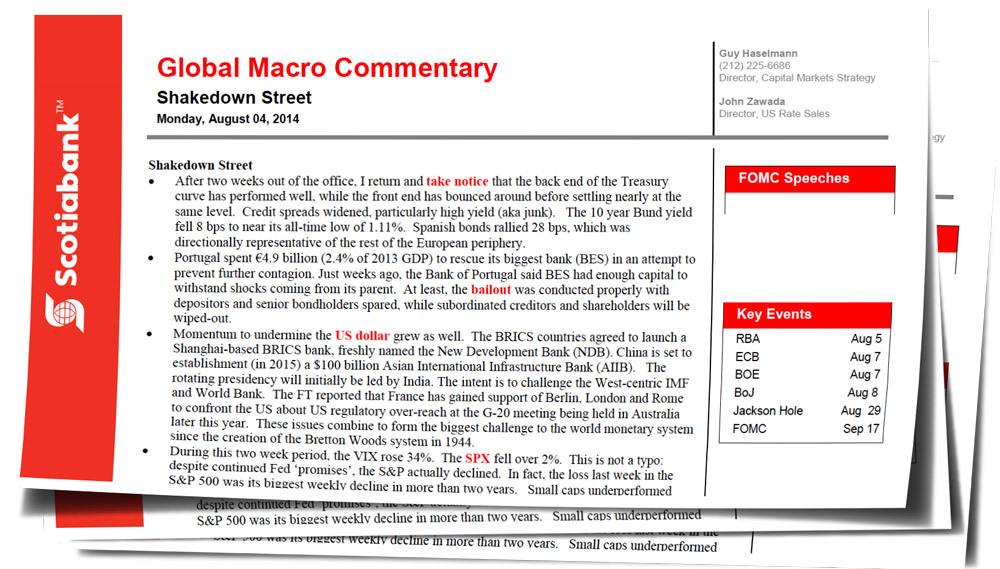Shakedown Street
by Guy Haselmann, Director, Capital Markets Strategy, Scotiabank GBM
• After two weeks out of the office, I return and take notice that the back end of the Treasury curve has performed well, while the front end has bounced around before settling nearly at the same level. Credit spreads widened, particularly high yield (aka junk). The 10 year Bund yield fell 8 bps to near its all-time low of 1.11%. Spanish bonds rallied 28 bps, which was directionally representative of the rest of the European periphery.
• Portugal spent €4.9 billion (2.4% of 2013 GDP) to rescue its biggest bank (BES) in an attempt to prevent further contagion. Just weeks ago, the Bank of Portugal said BES had enough capital to withstand shocks coming from its parent. At least, the bailout was conducted properly with depositors and senior bondholders spared, while subordinated creditors and shareholders will be wiped-out.
• Momentum to undermine the US dollar grew as well. The BRICS countries agreed to launch a Shanghai-based BRICS bank, freshly named the New Development Bank (NDB). China is set to establishment (in 2015) a $100 billion Asian International Infrastructure Bank (AIIB). The rotating presidency will initially be led by India. The intent is to challenge the West-centric IMF and World Bank. The FT reported that France has gained support of Berlin, London and Rome to confront the US about US regulatory over-reach at the G-20 meeting being held in Australia later this year. These issues combine to form the biggest challenge to the world monetary system since the creation of the Bretton Woods system in 1944.
• During this two week period, the VIX rose 34%. The SPX fell over 2%. This is not a typo: despite continued Fed ‘promises’, the S&P actually declined. In fact, the loss last week in the S&P 500 was its biggest weekly decline in more than two years. Small caps underperformed large caps. Defensive sectors like utilities and consumer staples (bond-like sectors) outperformed high P/E and high beta stocks. Warning signs are on the horizon.
• In addition, geo-political tensions ratcheted higher. Events in Gaza dominated the news, yet it was not the only noteworthy story. Syrian fighting has spilled into Lebanon. Libya disintegrated into violent multi-militia fighting, causing evacuations and embassy closings. ISIS advanced, capturing Iraq’s biggest damn and a Kurdish town. Argentina defaulted, triggering CDS payments. Additional and more significant Russian sanctions were announced; and Moscow responded with retaliatory measures. Incidents of Chinese social unrest and random attacks are growing in frequency and boldness. 60 Minutes news program re-broadcasted the story about the extent of China’s credit and housing bubbles (http://www.cbsnews.com/news/china-realestate- bubble-lesley-stahl-60-minutes/).
• On the domestic front, Obama bluntly admitted that “we tortured some folks” after 9/11. It was also revealed that CIA spies improperly accessed Senate computers; most likely a violation of the constitutional separation of powers. The over-reach experiments of the NSA, IRS, FOMC and (now) CIA have increased cries of Washington bureaucracy veering out of control.
• In addition, in an interview with The Economist, the President accused corporate leaders of being insincere and disingenuous, stating that there is a gap between their professed values and how their lobbyists operate. A man who is possibly carrying the Ebola virus is being quarantined in a NY hospital. Hopefully, the CDC’s recent mishandling of Small Pox and Anthrax samples is not representative of the government’s overall competencies.
• Markets recently have had a perverse reaction to economic data. Equity markets seem to fall on strong data and rally on weak data. In such, it seems fair to conclude that Fed accommodation continues to trump economic fundamentals. Therefore, it may be fair to conclude that a tepidly growing economy is likely best for risk assets. At the moment, this might be consistent with the Fed’s forecasts of modest improvement that will allow the FOMC to withdraw accommodation gradually and methodically. However, the odds of such a convenient outcome are small.
• Market volatility is highly likely to rise, because the FOMC’s future path will likely deviate from current forward pricing. There is a wide range of economic projections amongst market participants who will be forced to reassess and shift positions as data unfolds. Fortunately for the Fed, after QE ends in October, the FOMC will have greater flexibility.
• However, the Fed will have difficulties controlling market gyrations and its potential loss of credibility from troubles that are likely to arise from its exit strategy. If the economy strengthens, markets will be forced to price in a more aggressive Fed as consensus builds that it is ‘behind the curve’. If data weakens, the market will worry that the Fed has no ammunition; and regardless, markets would question QE’s effectiveness. Neither outcome is good for equities or credit, but long-dated Treasury Bonds would benefit. I maintain my prediction of a sub 3% 30 year by year end.
• “Long distance runner, what you holdin’ out for?” – Grateful Dead
You may read/download the full note below:













